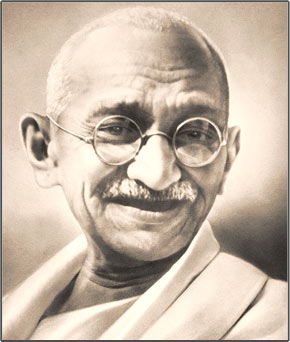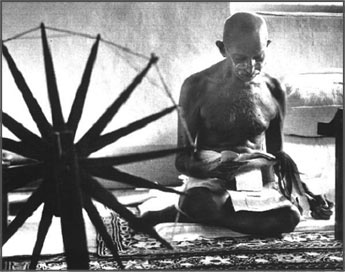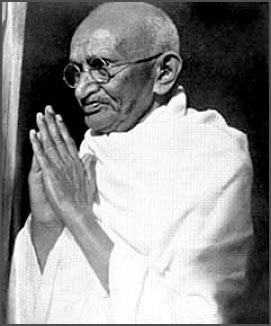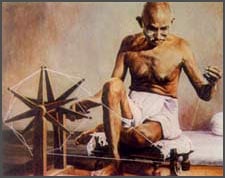மன்னும் இமயமலை யெங்கள் மலையே
மாநில மீதிது போற்பிறி திலையே!
இன்னறு நீர்க்கங்கை யாறெங்கள் யாறே
இங்கிதன் மாண்பிற் கெதிரெது வேறே?
பன்னரும் உபநிடநூ லெங்கள் நூலே
பார் மிசை யேதொரு நூல்இது போலே?
பொன்னொளிர் பாரதநா டெங்கள் நாடே
போற்றுவம் இஃதை எமக்கில்லை ஈடே.
மாரத வீரர் மலிந்தநன் னாடு
மாமுனி வோர்பலர் வாழ்ந்த பொன்னாடு
நாரத கான நலந்திகழ் நாடு
நல்லன யாவையும் நாடுறு நாடு
பூரண ஞானம் பொலிந்தநன் னாடு
புத்தர் பிரானருள் பொங்கிய நாடு
பாரத நாடு பழம்பெரு நாடே
பாடுவம் இஃதை எமக்கிலை ஈடே.
இன்னல்வந் துற்றிடும் போததற் கஞ்சோம்
ஏழைய ராகிஇனி மண்ணில் துஞ்சோம்
தன்னலம் பேணி இழிதொழில்கற் போம்
தாய்த்திரு நாடெனில் இனிக்கையை விரியோம்
கன்னலும் தேனும் கனியும் இன் பாலும்
கதலியும் செந்நெலும் நல்கும் எக் காலும்
உன்னத ஆரிய நாடெங்கள் நாடே
ஓதுவம் இஃதை எமக்கில்லை ஈடே.
Friday, December 11, 2009
எங்கள் நாடு
Thursday, December 10, 2009
பாரத தேசம்
பல்லவி
பாரத தேசமென்று பெயர்சொல்லு வார் - மிடிப்
பயங்கொல்லு வார்துயர்ப் பகைவெல்லு வார்.
சரணங்கள்
1. வெள்ளிப் பனிமலையின் மீதுலவு வோம் - அடி
மேலைக் கடல்முழுதும் கப்பல் விடுவோம்
பள்ளித் தலமனைத்தும் கோயில் செய்கு வோம், எங்கள்
பாரத தேசமென்று தோள்கொட்டுவோம். (பாரத)
2. சிங்களத் தீவினுக்கோர் பாலம் அமைப்போம்,
சேதுவை மேடுறுத்தி வீதி சமைப்போம்
வங்கத்தில் ஓடிவரும் நீரின் மிகையால்
மையத்து நாடுகளில் பயிர்செய்குவோம். (பாரத)
3. வெட்டுக் கனிகள் செய்து தங்கம் முதலாம்
வேறு பலபொருளும் குடைந் தெடுப்போம்,
எட்டுத் திசைகளிலுஞ் சென்றிவை விற்றே
எண்ணும் பொருளனைத்தும் கொண்டு வருவோம். (பாரத)
4. முத்துக் குளிப்பதொரு தென் கடலிலே,
மொய்த்து வணிகர்பல நாட்டினர்வந்தே,
நத்தி நமக்கினிய பொருள் கொணர்ந்தே
நம்மருள் வேண்டுவது மேற்க ரையிலே. (பாரத)
5. சிந்து நதியின்மிசை நிலவினி லே
சேர நன்னாட்டிளம் பெண்களுட னே
சுந்தரத் தெலுங்கினிற் பாட்டிசைத்துத்
தோணிக ளோட்டிவிளை யாடிவரு வோம். (பாரத)
6. கங்கை நதிப்புறத்துக் கோதுமைப் பண்டம்
காவிரி வெற்றிலைக்கு மாறுகொள்ளு வோம்
சிங்க மராட்டியர்தம் கவிதை கொண்டு
சேரத்துத் தந்தங்கள் பரிசளிப்போம். (பாரத)
7. காசி நகர்ப்புலவர் பேசும் உரை தான்
காஞ்சியில் கேட்பதற்கோர் கருவிசெய் வோம்
ராசபுத் தானத்து வீரர் தமக்கு
நல்லியற் கன்னடத்துத் தங்கம் அளிப்போம். (பாரத)
8. பட்டினில் ஆடையும் பஞ்சினில் உடையும்
பண்ணி மலைகளென வீதி குவிப்போம்
கட்டித் திரவியங்கள் கொண்டுவரு வார்
காசினி வணிகருக்கு அவை கொடுப்போம் (பாரத)
9. ஆயுதம் செய் வோம் நல்ல காகிதம் செய்வோம்
ஆலைகள் வைப்போம் கல்விச் சாலைகள் வைப்போம்
ஒயுதல்செய் யோம்தலை சாயுதல் செய்யோம்
உண்மைகள்சொல் வோம்பல வண்மைகள் செய்வோம். (பாரத)
10. குடைகள்செய் வோம்உழு படைகள் செய் வோம்
கோணிகள்செய் வோம் இரும் பாணிகள் செய்வோம்
நடையும் பறப்புமுணர் வண்டிகள் செய்வோம்
ஞாலம் நடுங்கவரும் கப்பல்கள் செய்வோம் (பாரத)
11. மந்திரம்கற் போம்வினைத் தந்திரம்கற் போம்
வானையளப் போம்கடல் மீனையளப்போம்
சந்திரமண் டலத்தியல் கண்டுதெளி வோம்
சந்திதெருப் பெருக்கும் சாத்திரம் கற்போம். (பாரத)
12. காவியம் செய்வோம் நல்ல காடு வளர்ப்போம்
கலைவளர்ப் போம் கொல்ல ருலைவளர்ப் போம்
ஓவியம்செய் வோம் நல்லஊசிகள் செய் வோம்
உலகத் தொழிலனைத்து முவந்து செய்வோம். (பாரத)
13. சாதி இரண்டொழிய வேறில்லை யென்றே
தமிழ்மகள் சொல்லியசொல் அமிழ்த மென்போம்
நீதிநெறி யினின்று பிறர்க்கு தவும்
நேர்மையர் மேலவர், கீழவர் மற்றோர். (பாரத)
பாரத நாடு
பல்லவி
பாருக்குள்ளே நல்ல நாடு - எங்கள்
பாரத நாடு.
சரணங்கள்
1. ஞானத்தி லேபர மோனத்திலே - உயர்
மானத்தி லேஅன்ன தானத்திலே
கானத்தி லேஅமு தாக நிறைந்த
கவிதையி லேஉயர் நாடு - இந்தப் (பாருக்)
2. தீரத்தி லேபடை வீரத்திலே - நெஞ்சில்
ஈரத்தி லேஉப காரத்திலே
சாரத்தி லேமிகு சாத்திரங் கண்டு
தருவதி லேஉயர் நாடு - இந்தப் (பாருக்)
3. நன்மையி லேஉடல் வன்மையிலே - செல்வப்
பன்மையி லேமறத் தன்மையிலே
பொன்மயி லொத்திடும் மாதர்தம் கற்பின்
புகழினி லேஉயர் நாடு - இந்தப் (பாருக்)
4. ஆக்கத்தி லேதொழில் ஊக்கத்திலே - புய
வீக்கத்தி லேஉயர் நோக்கத்திலே
காக்கத் திறல்கொண்ட மல்லர்தம் சேனைக்
கடலினி லேஉயர் நாடு - இந்தப் (பாருக்)
5. வண்மையி லேஉளத் திண்மையிலே - மனத்
தண்மையி லேமதி நுண்மையிலே
உண்மையி லேதவ றாத புலவர்
உணர்வினி லேஉயர் நாடு - இந்தப் (பாருக்)
6. யாகத்தி லேதவ வேகத்திலே - தனி
யோகத்தி லேபல போகத்திலே
ஆகத்தி லேதெய்வ பக்திகொண் டார்தம்
அருளினி லேஉயர் நாடு - இந்தப் (பாருக்)
7. ஆற்றினி லேசுனை யூற்றினிலே - தென்றல்
காற்றினி லேமலைப் பேற்றினிலே
ஏற்றினி லேபயன் ஈந்திடுங் காலி
இனத்தினி லேஉயர் நாடு - இந்தப் (பாருக்)
8. தோட்டத்தி லேமரக் கூட்டத்திலே - கனி
ஈட்டத்தி லேபயிர் ஊட்டத்திலே
தேட்டத்தி லேஅடங் காத நதியின்
சிறப்பினி லேஉயர் நாடு - இந்தப் (பாருக்)
நாட்டு வணக்கம்
எந்தையும் தாயும் மகிழ்ந்துகுலாவி
இருந்ததும் இந்நாடே - அதன்
முந்தையர் ஆயிரம் ஆண்டுகள் வாழ்ந்து
முடிந்ததும் இந்நாடே - அவர்
சிந்தையில் ஆயிரம் எண்ணம் வளர்ந்து
சிறந்ததும் இந்நாடே - இதை
வந்தனை கூறி மனத்தில் இருத்திஎன்
வாயுற வாழ்த்தேனோ? - இதை
'வந்தே மாதரம் வந்தே மாதரம்'
என்று வணங்கேனோ?
இன்னுயிர் தந்தெமை ஈன்று வளர்த்து, அருள்
ஈந்ததும் இந்நாடே - எங்கள்
அன்னையர் தோன்றி மழலைகள் கூறி
அறிந்ததும் இந்நாடே - அவர்
கன்னிய ராகி நிலவினி லாடிக்
களித்ததும் இந்நாடே - தங்கள்
பொன்னுடல் இன்புற நீர்விளை யாடி, இல்
போந்ததும் இந்நாடே - இதை
'வந்தே மாதரம் வந்மே மாதரம்'
என்று வணங்கேனோ?
மங்கைய ராயவர் இல்லறம் நன்கு
வளர்த்ததும் இந்நாடே - அவர்
தங்க மதலைகள் ஈன்றமு தூட்டித்
தழுவிய திந்நாடே - மக்கள்
துங்கம் உயர்ந்து வளர்கெனக் கோயில்கள்
சூழ்ந்ததும் இந்நாடே - பின்னர்
அங்கவர் மாய அவருடற் பூந்துகள்
ஆர்ந்ததும் இந்நாடே - இதை
'வந்தே மாதரம் வந்தே மாதரம்'
என்று வணங்கேனோ?
ஜய வந்தே மாதரம்
பல்லவி
வந்தே மாதரம் - ஜய
வந்தே மாதரம்.
சரணங்கள்
1. ஜயஜய பாரத ஜயஜய பாரத
ஜயஜய பாரத ஜயஜய ஜயஜய (வந்தே)
2. ஆரிய பூமியில் நாரிய ரும் நர
சூரிய ரும்சொலும் வீரிய வாசகம் (வந்தே)
3. நொந்தே போயினும் வெந்தே மாயினும்
நந்தே சத்தர்உ வந்தே சொல்வது (வந்தே)
4. ஒன்றாய் நின்றினி வென்றா யினுமுயிர்
சென்றா யினும்வலி குன்றா தோதுவம். (வந்தே)
வந்தே மாதரம்
பல்லவி
வந்தே மாதரம் என்போம் - எங்கள்
மாநிலத் தாயை வணங்குதும் என்போம். (வந்தே)
சரணங்கள்
1. ஜாதி மதங்களைப் பாரோம் - உயர்
ஜன்மம்இத் தேசத்தில் எய்தின ராயின்
வேதிய ராயினும் ஒன்றே - அன்றி
வேறு குலத்தின ராயினும் ஒன்றே (வந்தே)
2. ஈனப் பறையர்க ளேனும் அவர்
எம்முடன் வாழ்ந்திங் கிருப்பவர் அன்றோ?
சீனத் தராய்விடு வாரோ? - பிற
தேசத்தர் போற்பல தீங்கிழைப் பாரோ? (வந்தே)
3. ஆயிரம் உண்டிங்கு ஜாதி - எனில்
அன்னியர் வந்து புகல்என்ன நீதி? - ஓர்
தாயின் வயிற்றில் பிறந்தோர் - தம்முள்
சண்டைசெய் தாலும் சகோதரர் அன்றோ? (வந்தே)
4. ஒன்று பட்டால் உண்டு வாழ்வே - நம்மில்
ஒற்றுமை நீங்கில் அனைவர்க்கும் தாழ்வே
நன்றிது தேர்ந்திடல் வேண்டும் - இந்த
ஞானம் வந்தாற்பின் நமக்கெது வேண்டும்? (வந்தே)
5. எப்பதம் வாய்த்திடு மேனும் - நம்மில்
யாவர்க்கும் அந்த நிலைபொது வாகும்
முப்பது கோடியும் வாழ்வோம் - வீழில்
முப்பது கோடி முழுமையும் வீழ்வோம் (வந்தே)
6. புல்லடி மைத்தொழில் பேணிப் - பண்டு
போயின நாட்களுக் கினிமனம் நாணித்
தொல்லை இகழ்ச்சிகள் தீர - இந்தத்
தொண்டு நிலைமையைத் தூவென்று தள்ளி (வந்தே)
Friday, May 1, 2009
Gandhi(1982)-DvDrip XVID

http://www.mediafire.com/file/dltdjy4dotz/Gandhi(1982)-DvDrip XVID AC3.WWW.AMADERFORUM.COM.avi.001
http://www.mediafire.com/file/ttulcggtywi/Gandhi(1982)-DvDrip XVID AC3.WWW.AMADERFORUM.COM.avi.002
http://www.mediafire.com/file/unutzljlnzf/Gandhi(1982)-DvDrip XVID AC3.WWW.AMADERFORUM.COM.avi.003
http://www.mediafire.com/file/3joqt5d14yi/Gandhi(1982)-DvDrip XVID AC3.WWW.AMADERFORUM.COM.avi.004
http://www.mediafire.com/file/keod2l2myce/Gandhi(1982)-DvDrip XVID AC3.WWW.AMADERFORUM.COM.avi.005
http://www.mediafire.com/file/mdnlhn2tbyq/Gandhi(1982)-DvDrip XVID AC3.WWW.AMADERFORUM.COM.avi.006
http://www.mediafire.com/file/z2t2jh1nu2g/Gandhi(1982)-DvDrip XVID AC3.WWW.AMADERFORUM.COM.avi.007
http://www.mediafire.com/file/jk2mztz2mky/Gandhi(1982)-DvDrip XVID AC3.WWW.AMADERFORUM.COM.avi.008
http://www.mediafire.com/file/jn1yqzfmfym/Gandhi(1982)-DvDrip XVID AC3.WWW.AMADERFORUM.COM.avi.009
http://www.mediafire.com/file/2hwwzyi4mzt/Gandhi(1982)-DvDrip XVID AC3.WWW.AMADERFORUM.COM.avi.010
http://www.mediafire.com/file/mwjkximlmmn/Gandhi(1982)-DvDrip XVID AC3.WWW.AMADERFORUM.COM.avi.011
http://www.mediafire.com/file/zdygmzzzvmi/Gandhi(1982)-DvDrip XVID AC3.WWW.AMADERFORUM.COM.avi.012
Dr Manmohan Singh Biography
| |||||||||||||||
| | |||||||||||||||
| |||||||||||||||
Thursday, April 30, 2009
Dhoni's Achievements
Career Highlights
- Became the first captain to lead India to the ICC World Twenty 20 trophy played in South Africa in September 2007 which India won on the 24th September 2007
- Second Indian captain after Kapil Dev to have won a World cup
Awards
- On the 13th of February 2006, became the man of the match against Pakistan at Gadaffi Stadium for an unbeaten 72 runs
- Made man of the match against Sri Lanka on the 31st of October 2005 for scoring his highest ever unbeaten 183 runs at Sawai Mansingh Stadium
- Receives his first man of the match award against Pakistan at AC-VDCA Stadium for scoring 148 runs on the 5th of April 2005
Ranking
- On the 19th of April 2006, moves to the top at no. 1 position on LG’s ICC ODI player rankings
- Ranked at no. 2 position on LG’s ICC ODI player rankings on the 16th of April 2006
Records
- On the 17th of January 2008, became the first Indian wicketkeeper to effect five international dismissals in an innings against Australia - equalling Adam Gilchrist’s record
- Holds the record for highest runs scored by a wicketkeeper, i.e. 183 not out
- His innings of 183 not out is the highest score made by anyone in the second innings of an ODI. The former record was held by Brian Lara for scoring 153 against Pakistan
- Became the first Indian to hit 10 sixes in an ODI
- Made a record of scoring 120 runs in an ODI from boundaries and sixes(15 boundaries and 10 sixes)
- Is the only second Indian to reach 1st position on LG’s ICC ODI batting rankings
Other Achievements
- Won the Pepsi & MTV Youth Icon of the year 2006
- Nominated for NDTV Youth Icon of the year 2006
Dhoni Biography

Personal information
Full name: Mahendra Singh Dhoni
D.O.B: 7th July, 1981
Place of Birth: Ranchi, Bihar
Nickname: Mahi
Cricketing information
Role: Captain of the Indian ODI and Twenty20 team and Vice captain of the Test team
Batting style: Right hand batsman
Bowling style: Right arm medium
Field position: Wicketkeeper
Clubs played: Jharkhand
Cricketing profile
Mahendra Singh Dhoni started his first class career in the year 1999-2000. His one day international debut came after playing five years of first class cricket on the 23rd of December 2004 against Bangladesh. The venue of the match was in Chittagong, Bangladesh. Unfortunately, he was run out on the first ball he faced. It wasn’t a great debut for him where batting is concerned. Luck wasn’t on his side in the first four matches he played. Where as on the fifth match which was played against Pakistan in Visakhapatnam, Dhoni came to the crease one down and managed to score 148 runs from just 123 balls. He hit 15 boundaries and four sixes. He got his first man of the match award that day. Not only a good wicketkeeper but Dhoni proved himself to be a first class batsman too. He is one of the few finest wicketkeeper batsman India has seen after a very long time.
On the 31st of October, Dhoni broke the record of highest runs scored by a wicket keeper by securing 183 runs against Srilanka which was played at Jaipur. Adam Gilchrist was the former record holder with 172 runs.
Before he started playing cricket, he was a football goalkeeper. Its said he drinks around four litres of milk everyday but he denied it by saying that has been exaggerated a bit. He said he loves milk and drinks around a litre on a daily basis.
On the 2nd of December 2005, Dhoni made his Test cricket debut against Srilanka which was played in Chennai, India.
Personal profile
Dhoni was born and brought up in the city of Ranchi. He has two siblings. A sister who is married and a brother who lives in Almora. Almora is a high-lying town at the foot of the Himalaya which is his father’s home town. His father’s name is Pan Singh and mother’s name is Devki Devi.
His hobbies and interests include:
- Hearing music, ghazals and songs by Lata Mangeshkar and Kishore Kumar
- Loves to ride bikes
- Enjoys playing computer games and badminton
Not interested in:
- English songs
- Working out at gyms
Special qualities:
- Thinks positive
- Highly confident about himself
- Is aggressive on the field
His Idol:
- Adam Gilchrist
Hemant Karkare Biography

Hemant Karkare was born in 1954. Not much is known about his childhood, but he went on to attain a Bachelor of Engineering degree from Vishveshvarayya Regional Engineering in Nagpur, the largest city in central India. In 1982, he became a batch Indian Police Service (IPS) officer and slowly worked his way up the ranks, receiving posts at Nanded, Akola, Thane and Bhiwandi. Then, nine years later, he was sent to a post in the Chandrapur area of the state. Finally, he ended up in Mumbai, where he acted as the deputy commissioner of police in their economic offense wing. He also worked in the research and analysis wing -- the country's external intelligence agency -- out of Austria for seven years.
Success
Hemant Karkare helped to solve the serial bomb blasts in Thane, Panvel and Vashi, and also helped in the investigation of the September 29, 2008 blast in Malegaon. Known for his discipline and fair investigation tactics, he encouraged his officers to "play fair," stating, "We should do our job and it is for the court to decide.”
He was killed in November 2008 while leading an offensive against terrorists at the Taj Hotel.
Quotes
"He is a good and upright officer, a law enforcing officer and has a good track record."
- Arvind Inamdar, Senior and former Maharashtra Director General of Police about Hemant Karkare just prior to his assassination.
Sunday, April 26, 2009
Ilayaraja Biography
 Date of Birth 2 June 1943, Pannaipuram, Madurai District, Tamil Nadu, India
Date of Birth 2 June 1943, Pannaipuram, Madurai District, Tamil Nadu, IndiaBirth Name: Daniel Rajayya
Nickname: Raasaiya
Mini Biography
Born and brought up in an obscure village near Kambam in Southern Tamil Nadu, Ilayaraja became the first Asian to score a symphony for the London Philharmonic Orchestra, besides scoring over 500 feature films in a period of 20 years. Raja, as he is popularly known and affectionately called, comes from a family of musicians. His mother, a huge repository of Tamil folk songs, seems to be a very strong influence in his music. He learned to play the harmonium, the typical musical instrument used in street performances. The team of the brothers, the eldest being Pavalar Varadharajan, a poet, worked as a group of musicians traveling across the state, accompanying theater artists. Raja picked up most of his acumen for audience tastes during this period.
In 1969, Raja migrated to the city of Madras, the Southern Movie capital, when he was 29 years old, looking for a break into music making for the public. He studied under Dhanraj Master, playing the guitar and piano in the Western style. He later earned a diploma in music from Trinity College in London. Ilayaraja's break into music for films came with Annakili (1976). The film dealt with a village story, to which Ilayaraja composed great melodies. The songs offered simplicity and musicality typical of Tamil folk in an authentic way, and they offered new sounds--rich orchestration typical of Western music. The songs became an instant hit, the most popular being "Machchana Partheengala" sung by a female voice, S. Janaki. This was followed by a series of films that portrayed contemporary Tamil villages in an authentic way, against stylistic shallow portrayals before. For all of these films Raja created memorable songs. Most popular were the songs "Senthoorappove" and "Aatukkutti Mutaiyittu" from Pathinaru Vayathinile (1977), and "Samakkozhi" and "Oram Po" from Ponnu Oorukku Pudhusu (1979).
Raja soon proved his abilities in other styles as well. classical Karnatic melodies were used in Kannan Oru Kai Kuzhandhai (1978) (Rag Mohanam), Mayile Mayile (Ragam Hamsadhwani), and Chinna Kannan Azhaikiran (Reethi Gowlai). Raja's grasp of Western classical structure became evident with his masterful use of the piano, guitar, and string ensembles. Some of the numbers that show his orchestral genius are "Pon malai Pozhudu" and "Poongadhave" from Nizhalgal (1980), Kanmaniye Kadhal from Aarilirindhu Aruvathu Varai (1979), "Ramanin Mohanam" from Netri Kann (1981), "En Iniya Pon nilave from Moodupani (1980), "Paruvame Pudhiya" from Nenjathai Killathe (1981), and "Edho Moham" from Kozhi Koovuthu (1982). These songs could literally be heard coming from every doorstep in Tamil Nadu state every day for at least a year after being released. Raja composed film music prolifically for the next fifteen years, at a rate of as many as three new songs a day. After a few years as a film composer, he could write all the parts to a score as they came to him, and his assistants would make fair copies, which would be recorded immediately.
Raja went for a trip abroad to Europe, partly to visit places where Wolfgang Amadeus Mozart, Johann Sebastian Bach, and Ludwig van Beethoven lived. They were his Manasika Gurus or non-physical teachers, he wrote once. He also met contemporary composers and arrangers including Paul Mauriat. His listeners were awestruck by the quality and quantity of his musical output. He also scored a few films abroad. Ilayaraja's image grew to be a unique one in the history of Tamil cinema: stories, themes, and castes would be changed to fit his music, which swept away the minds of millions of Indians in hundreds of films.
Ilayaraja also recorded non-film albums, such as "How to Name It" and "Nothing But Wind," which were well-received in India and abroad. In 1993, he wrote a symphony for the London Philharmonic Orchestra in an amazing one-month span. To many people who know him, Raja represents more than his music. He is a mark of great achievement that is possible by hard work, yet he is seen in most of his interviews as talking very philosophically. He is very much attracted by the philosophy of Ramana Maharishi of Thiruvanna Malai, who lived in the early 20th Century. Raja once referred to Ramana as "our Zen master."
Trivia
He won a gold medal from London's Trinity College in the guitar category. His notable works include Nayakan (1987) (his 400th film) and Anjali (1990) (his 500th film). His other musical works include "Nothing But the Wind," "How to Name It," and "Singing Skylarks." He also invented a new Carnatic raga known as Panchamukhi.
Personal Quotes
"About 10 years ago I undertook to construct the principal towers of the Siva temple at Thiruvanamalai and the Vaishnavite temple at Srirangam; I spent my own money on the projects - I did not collect money from others. I could have completed Thiruvasagam also without financial assistance from others, but did not wish to do so. Because, when the project was conceived, I was reminded of a remark made by the late Kanchi Senior Acharya. He said that in the olden days, even if a king wanted to construct a temple tower, he would not do it with his own money, but collected finds from the people for the purpose. The idea was that there should be participation by the people. That was why I was keen that others should also join in this venture."
"Give me half an hour and I can finish a film."
"Western classical music is perspective - look at the number of people involved in a symphony! Our traditional music is lonely."
About Budapest: "For the last 3 years, I have been doing most of my recordings there. The artistes there are very talented - it's a renowned organization with 100 years of experience and is among the world's best orchestras. The conductor, Loslo Kovacs, has been very close to me - I find it easier to work with him than my own brother! Vienna is where most of the world's greatest composers have worked. From the classical to the romantic periods, great figures like [Wolfgang Amadeus] Mozart, [Johann] Strauss, [Johann Sebastian] Bach and [Ludwig von] Beethoven had Vienna connections. Those veterans would have visited Hungary and conducted performances here. My attachment and respect for that soil have also influenced by decision in selecting the Budapest Symphony Orchestra for Thiruvasagam."
About Thiruvasagam: "Like most Tamils, I have great admiration and reverence for Thiruvasagam. It is one of our great treasures. Its unique feature is its emotional appeal to readers. Manickavasagar sings the praise of Shiva and profusely thanks Him. While doing so he calls himself "meaner than a dog," "man of evil deeds," and so on. Manickvasagar, the prime minister of a Pandya king, should have overcome his ego before doing this. In moving, bone-melting words, he makes a sort of confession to God. Because of their very emotional nature, his poems reach the people. All his works are highly emotional and are bound to appeal to every reader. If his songs were mere statements of facts, without an appeal to your heart, they would have had no impact. Thiruvasagam, therefore, occupies a special place in Tamil literature. Hence the traditional saying: "Those who are not moved by Thiruvasagam will not be moved by any other work." I started working on the project as early as 2000. When I approached big people for funds (I won't mention any names), many could not even understand the concept or its significance - they did not realize that it would get a place in history later. They saw it only as scoring music for some devotional songs and wondered why it should be so expensive. They did not respond. More than their refusal to participate, I was hurt by the way they approached the project. Generally I do not go for such help."
Where Are They Now
Composing for new movies. Writing about the philosophy of Astavakra Gita.
A.R.RAHMAN Biography

Date of Birth
6 January 1966, Madras (now Chennai), IndiaBirth Name
A.S. Dileep KumarNickname
The Mozart of MadrasIsai Puyal
Mini Biography
Allah Rakha Rahman was born A.S. Dileep Kumar on January 6, 1966, in Madras (now Chennai), India, to a musically affluent family. Dileep started learning the piano at the age of 4, and at the age of 9, his father passed away. Since the pressure of supporting his family fell on him, he joined Ilayaraja's troupe as a keyboard player at the age of 11. He dropped out of school as a result of this and traveled all around the world with various orchestras.
He accompanied the great tabla maestro Zakir Hussain on a few world tours and also won a scholarship at the Trinity College of Music at Oxford University, where he studied Western classical music and obtained a degree in music. Due to some personal crisis, Dileep Kumar embraced Islam and came to be known as A.R. Rahman. In 1987, he moved to advertising, where he composed more than 300 jingles over 5 years. In 1989, he started a small studio called Panchathan Record Inn, which later developed into one of the most well-equipped and advanced sound recording studios in India.
At an advertising awards function, Rahman met one of India's most famous directors, Mani Ratnam. Rahman played him a few of his music samples. Mani loved them so much that he asked Rahman to compose the music for his next film, Roja (1992). The rest, as they say, is history. He went on to compose several great hits for Tamil-language films before composing the score and songs for his first Hindi-language film, Rangeela (1995). The enormous success of his first Hindi venture was followed by the chart-topping soundtrack albums of films such as Bumbai (1995) , Dil Se.. (1998), Taal (1999), Zubeidaa (2001), and Lagaan: Once Upon a Time in India (2001), which was nominated for best foreign-language film at the 2002 Academy Awards.
More recently, he worked with Sir Andrew Lloyd Webber and Shekhar Kapur (director of Elizabeth (1998)) on a musical called "Bombay Dreams." At 36 years old, A.R. Rahman has revolutionized Indian film music and one can only expect this musical genius to reach greater heights.
Trade Mark
His music always has a Southern Indian influence.
Trivia
Studied Western classical music as a student at Oxford University in the UK.
He was nominated for a 2003 Laurence Olivier Theatre Award (The Hilton Award) for Best New Musical of 2002, "Bombay Dreams," performed at the Apollo Theatre, West End, London, and on Broadway in New York City.
On August 15, 1997, he released an album called "Vande Mataram," on Columbia/SME Records, to commemorate 50 years of Indian independence. A tribute to the motherland, it featured songs for each of the Indian flag colors. The album was released simultaneously across the world in 28 countries, and Rahman himself performed in New Delhi to a packed audience including the honorable Indian Prime Minister. Over 1.2 million copies were sold in India alone.
Also known as the John Williams of the Indian Film Industry.
Collaborated on The Lord of The Rings' Stage Musical original score with Finnish folk music group Varttina and Christopher Nightingale.
Personal Quotes
"I have rubbed many a producer the wrong way by disturbing the schedule, but it has paid off."
"I wasn't too happy with the I-don't-want-to-listen-to-it attitude of our youngsters towards film music. Why can't we get our guys to listen to our own music rather than to Michael Jackson? I didn't want us to lose the market to the West. The music had to be cool and rooted, and yet had to branch out. It was like the wild imagination of a child... but it worked... it did travel beyond Madras and attract people."
About his belief in Sufism: "I'm a deeply spiritual person. Sufism is about love - love for a fellow human, love for all round humanity, and ultimately love for God. For me, it's where music and religion meet - at dargahs, you will find qawwalis. That's my inspiration."
About his song Vande Mataram: "It had to be unlike the one played on the radio for years. I wanted a sound that would connect me with people and capture a collective energy."
I hate the word [Bollywood]. I think it's derivative and it doesn't represent the entire film community in India. There's the eastern film industry, four industries in the south - they all make extraordinary films. It's like saying the whole of the West is Hollywood.
Where Are They Now
(March 2004) The Broadway debut of Bombay Dreams will take place on March 28, 2004 at the Broadway Theatre in New York City.
About Blaaze
Thursday, April 23, 2009
Havildar Major Piru Singh

Company Havildar Major Piru Singh, was born on 20 May 1918 in Rajasthan. He was enrolled in the 6 Rajputana Rifles on 20 May 1936. During the Jammu & Kashmir operations in summer of 1948, Pakistani raiders mounted a strong counter offensive in the Tithwal sector. The enemy also forced the Indian Army to vacate their forward positions across river Kishanganga. After the setback, Indian troops took position on the Tithwal ridge. At this juncture, 6 Rajputana Rifles was moved from Uri to Tithwal to strengthen the 163 Bde in its impending offensive in the sector. The Indian offensive commenced on 11 July 1948. The operation went on well till July 15th. The recon reports, however, revealed that the enemy was holding a high feature in the area and that its capture was essential for making any further progress. Further ahead lay another feature also held in strength by the enemy.
The 6 Rajputana Rifles was assigned the task of securing these two features. The 'D' Company was to secure the first feature. The 'C' Company was to capture the second feature after the 'D' Company had carried out its task. The 'D' Company launched its attack on the objective at 0130 hrs on July 18th. The path to the objective was about one metre wide with deep ravines on either side. Overlooking this narrow path were the hidden enemy bunkers. The company was subjected to heavy fire and with half an hour it suffered 51 casualties. During this battle, CHM Singh was with the leading section of the company, more than half of which was mowed down by the devastating fire of the enemy. He rushed forward to deal with the enemy medium machine gun post which was playing havoc with his troops. Enemy grenade splinters ripped open his clothes and wounded several parts of his body. But this did not deter him. He still continued the advance, shouting the battle cry, "Raja Ramchandra Ki Jai". Rushing forward he bayonetted the crew of the enemy MMG, with his own sten gun, silenced the menacing gun and occupied the post. By this time all his companions lay behind either dead or wounded.
The responsibility of clearing the enemy from the hill feature lay with him alone. Bleeding profusely he inched forward to attack the second enemy MMG post. At this juncture a grenade wounded him in the face. The blood dripping from his face almost blinded him. By now all the sten gun ammunition with him had been spent. He courageously crawled out of the occupied enemy trench and hurled grenades at the next enemy post. CHM Singh then jumped into another trench and bayonetted two enemy soldiers to death. As CHM Singh, emerged out of the second trench to charge on the third enemy bunker, he was hit in head by a bullet and was seen dropping on the edge of the enemy trench. There was an explosion in the trench which showed that the grenade had done its work. By then CHM Piru Singh's wound had proved fatal. "He paid with his life for his singularity brave act, but he left for the rest of his comrades a unique example of single-handed bravery and determined cold courage. The country is grateful," wrote Prime Minister Jawaharlal Nehru to Mrs. Tarawati, 75-year old mother of Company Havildar Major Piru Singh, "for this sacrifice made in the service of the Motherland, and it is our prayer that this may give you some peace and solace." Company Havildar Major Piru Singh was honoured with the highest war-time gallantry medal, Param Vir Chakra, posthumously. Jai Hind!! Jai Jawan!!
Bhagat Singh(1907 - 1931)
Having passed the fifth class from his village school, Bhagat Singh joined Dayanand Anglo-Vedic School in Lahore. In response to the call of Mahatma Gandhl and other nationalist leaders, to boycott government aided institutions, he left his school and enrolled in the National College at Lahore. He was successful in passing a special examination preparatory to entering college. He was reading for his B.A. examination when his parents planned to have him married. He vehemently rejected the suggestion and said that, if his marriage was to take place in Slave-India, my bride shall be only death." Rather than allow his father to proceed any further with the proposal, Bhagat Singh left home and went to Kanpur where he took up a job in the Pratap Press. In his spare time, he studied revolutionary literature. He joined the Hindustan Republican Association, a radical group, later known as the Hindustan Socialist Republican Association. When Bhagat Singh was assured that he would not be compelled to marry and violate his vows sworn to his motherland, he returned to his home in Lahore. This was in 1925 when a morcha had been going on at Jaito to protest against the deposition by the British of Maharaja Ripudaman Singh of Nabha because of his sympathy with the Akali agitation. A warrant for the arrest of Bhagat Singh was issued because he had accorded a welcome to one of the jathas, but he managed to elude the police and spent five months under the assumed name of Balvant Singh in Delhi, where he worked in a daily paper Vir Arjun.
As Akali activity subsided, Bhagat Singh returned to Lahore. He established contact with the Kirti Kisan Party and started contributing regularly to its magazine, the Kirti. He also remained in touch with the Hindustan Socialist Republican Association. In March 1926 was formed the Naujawan Bharat Sabha. Bhagat Singh, one of the principal organizers became its secretary. As the Simon Commission arrived at Lahore on 30 October 1928, an all-parties procession, headed by Lala Lajpat Rai, marched towards the railway station to make a protest. Intercepting the procession, police made a laths charge and Lala Lajpat Rai received injuries. He died a fornight later. Although the British saw no connection between the lathi charge and Lala Lajpat Rai's death, Bhagat Singh and his associates did. They plotted the assassination of Mr Scott, the Superintendent of Police, believed to have been responsible for the laths blows given Lala Lajpat Rai, but instead J.P. Saunders, an Assistant Superintendent of Police, became the actual victim owing to mistake in identification. Bhagat Singh and Rajguru had done the actual shooting. They and those who had served as lookouts escaped through the D.A.V. College grounds. The next day a leaflet was circulated by the Hindustan Socialist Republican Association announcing that the death of Lala Lajpat Rai had been avenged.

Bhagat Singh escaped to Calcutta disguised as a wealthy personage. He remained quiet for several months, but became active again when Public Safety Bill and the Trade Disputes Bill were being debated in Delhi. As his group resolved to explode a bomb to express disapproval of the bill, Bhagat Singh and B.K. Dutt volunteered to carry out the plan. They were seated in the gallery of the Central Assembly Hall awaiting the reading of the proclamation that would enact the bills. When the announcement was made, Bhagat Singh jumped up and threw a relatively harmless bomb behind one of the members' benches. There was an explosion, followed by still another from a second bomb. No one was seriously injured. Bhagat Singh and Dutt began shouting revolutionary slogans and threw leaflets explaining their in tent of making "the deaf hear" with the loud noise of explosion. Both were promptly taken into custody. As the trial proceeded, a statement, written in its entirety by Bhagat Singh, was read in defence of the two accused. Bhagat Singh said that "force used for a legitimate cause has its moral justification." He and B.K. Dutt were found guilty and sentenced to transportation for life. After the sentence had been pronounced in the Assembly Bomb case, Bhagat Singh was bound over for trial in the Saunders Murder case, approvers having identified his role in the killing. While awaiting trial in the Lahore Jail, Bhagat Singh started a hunger strike in behalf of political prisoners. The fast was continued even after the hearing of the case began on 10 July 1929, and was subsequently joined by many others. It was not until after the death of one of these, J.N. Das, on 13 September 1929, that facilities were promised to the prisoners and the hunger-strike abandoned.
At the time of trial, Bhagat Singh offered no defence, but utilized the occasion to propagate his ideal of freedom. He and his fellow accused kept delaying the proceedings by refusing to appear before the court, by ignoring what was going on, or by disrupting the work by shouting revolutionary slogans. He heard with defiant courage the death-sentence pronounced on 7 October 1930. In the same spirit, he kissed the hangman's noose on 23 March 1931, shouting for the last time his favourite cry, "Down with British imperialism." His body was secretly cremated at Husainivala by police and the remains thrown into the River Sutlej. The next day, however, his comrades collected the bodily remains from the cremation site and a procession was taken out in Lahore. Mourning for him was spontaneous and widespread and homage was paid to him for his sterling character and sacrifice.
In 1950, after Independence, the land where Bhagat Singh and his companions were cremated was procured from Pakistan and a memorial built. In March 1961, a Shahidi Mela was held there. Every year, on 23 March, the martyr's memory is similarly honoured. The old memorial, destroyed in the 1971 Indo-Pak war, has been rebuilt Bhagat Singh is remembered by the endearing title of Shahid-i-Azam, the greatest of martyrs.
Paying his tribute to him at a meeting of the Central Sikh League atAmritsar on 8 April 1931, Subhas Chandra Bose said, Bhagat Singh who set an example of character and patriotism by sacrificing himself for the sake of the country's freedom, was from the Sikh community. Today, he is known to be a brave Sikh hero throughout the world The Sikh community has to produce thousands of Bhagat Singhs for the cause of the country."
Wednesday, April 22, 2009
History Of Taj Mahal

Taj Mahal stands in the city of Agra, in the northern Indian state of Uttar Pradesh, on the banks of the Yamuna River. It was built in the memory of the beautiful Arjumand Bano Begum, who won the heart of a Mughal prince. She was married at 21 to Emperor Jahangir’s third son Prince Khurram and stayed loyally by his side through good times and bad: in the luxurious royal palaces of Agra as well as the transient tents of war camps.
In AD 1628, Khurram became king after a bloody battle of succession: he took the name Shahjahan or “King of the World” and showered his beloved begum with the highest titles. She became Mumtaz Mahal, the exalted of the palace and Mumtaz-ul-Zamani, the exalted of the Age. But Mumtaz Mahal was not destined to be queen for long.
In 1631, Shahjahan went on an expedition to the south and, as always, Mumtaz Mahal accompanied him. But she died in childbirth at Burhanpur. She had borne Shahjahan fourteen children, of whom four sons and three daughters survived. When Mumtaz Mahal died, she was just 39 years old. Shahjahan was inconsolable and contemporary chronicles tell of the royal court mourning for two years. there was no music, no feasting, and no celebration of any kind.
Epitome Of Love -Taj Mahal
Shahjahan, who was a passionate builder, now decided to erect a memorial to his queen in pristine marble that the world would never forget. The site selected for the tomb was a garden by the Yamuna river, unshadowed by any other structure. The garden had been laid by Raja Man Singh of Amber and now belonged to his grndson, Raja Jai Singh. By a royal firman, Shahjahan gave Jai Singh four havelis in exchange for the garden. The site was also chosen because it was located on a bend in the river, and so could be seen from Shahjahan’s personal palace in Agra Fort, further upstream.
Construction Of The Mausoleum - Taj Mahal
Work on the mausoleum began in 1633 and 20,000 workers laboured for 17 years to build it. The most skilled architects, inlay craftsmen, calligraphers, stone-carvers and masons came from all across Indian and lands as distant as Persia and Turkey. The master mason was from Baghdab, an expert in building the double dome from Persia, and an inlay specialist from Delhi.
Yemen sent agates, the corals came from Arabia, the garnets from Bundelkhand, onyx and amethyst from Persia. Mumtaz Mahal’s final resting-place was ornamented like a queen’s jewel-box.
பாரதியாரின் "கேட்பன"
நலங்கெடப் புழுதியி லெறிவ துண்டோ?
சொல்லடி சிவசத்தி! - எனைச்
சுடர்மிகு மறிவுடன் படைத்து விட்டாய்,
வல்லமை தாராயோ,- ந்த
மாநிலம் பயனுற வாழ்வதற்கே?
சொல்லடி, சிவசத்தி! - நிலச்
சுமையென வாழ்ந்திடப் புரிகுவையோ?
விசையுறு பந்தினைப்போல் - உள்ளம்
வேண்டிய படிசெலும் உடல்கேட்டேன்,
நசையறு மனங்கேட்டேன், - நித்தம்
நவமெனச் சுடர்தரும் உயிர்கேட்டேன்,
தசையினைத் தீசுடினும் - சிவ
சத்தியைப் படுநல் லகங்கேட்டேன்,
அசைவறு மதிகேட்டேன், - வை
அருள்வதில் உனக்கெதுந் தடையுளதோ?
INDIAN PARLIAMENT HOUSE
 The Parliament House is one of the most magnificent buildings in New Delhi which has one of the brightest clusters of architectural gems possessed by any country in the world. The building was designed by two famous architects – Sir Edwin Lutyens and Sir Herbert Baker – who were responsible for the planning and construction of New Delhi. Parliament House is a massive circular edifice, 560 feet (170.69 metres) in diameter. Its circumference is one-third of a mile and it covers an area of nearly six acres (24281.16 square metres). The open verandah on the first floor is fringed with a colonnade of 144 creamy sandstone columns, each 27 feet (8.23 metres) high.
The Parliament House is one of the most magnificent buildings in New Delhi which has one of the brightest clusters of architectural gems possessed by any country in the world. The building was designed by two famous architects – Sir Edwin Lutyens and Sir Herbert Baker – who were responsible for the planning and construction of New Delhi. Parliament House is a massive circular edifice, 560 feet (170.69 metres) in diameter. Its circumference is one-third of a mile and it covers an area of nearly six acres (24281.16 square metres). The open verandah on the first floor is fringed with a colonnade of 144 creamy sandstone columns, each 27 feet (8.23 metres) high.
 |
The Central Hall of Parliament House has been witness to many historic events. The Central Hall, located at the centre of the circular Parliament House, is surrounded by three Chambers and three well laid-out courtyards with lush green lawns and fountains. You will find short passages radiating from three equidistant points on the circumference of the Hall connecting with the Lok Sabha Chamber, the Rajya Sabha Chamber and the earlier Library Hall. Its dome, 29.9 metres (98 feet) in height, is one of the most magnificent domes in the world. It was in this Central Hall that India began its tryst with destiny on the midnight of 14-15 August 1947. Our Constituent Assembly which framed the Constitution of India met in this very Hall. One finds it adorned with portraits of eminent national leaders whose memories we dearly cherish. The President of India addresses members of both Houses of Parliament assembled together in this Hall which is also used for other ceremonial occasions. When the Parliament is in session, the Central Hall is used by members of Parliament as a common lobby for informal discussions among themselves.
 |
The Chamber of the Lok Sabha is semi-circular in shape with a floor area of about 4800 square feet (446 square metres). The Chair of the Speaker is placed conspicuously at the centre of the diameter connecting the two ends of the semi-circle. In the pit of the Chamber just below the Speaker’s Chair is the table of the Secretary-General of the House. The Chamber has seating accommodation for 550 members. In the wood work around the Lok Sabha Chamber, there are 35 gilded designs representing the various Provinces of Undivided India, the Dominions and certain other British Settlements.
 |
The Rajya Sabha Chamber is almost on the same pattern as that of the Lok Sabha Chamber but it is smaller in size, with a seating capacity of 250.
As one enters the Parliament House, one is fascinated by a row of beautiful paintings adorning the walls of the outer circular corridor on the ground floor. The paintings are the works of eminent artists of India, depicting scenes from the long history of this country right from the Vedic age down to the British period culminating in the attainment of Independence in 1947.
There are several passages of noble words described on the Parliament Building which serve as the guiding spirit for the deliberations in the two Houses
Tuesday, April 21, 2009
Mother Teresa Quote
- Be faithful in small things because it is in them that your strength lies.
- Do not think that love, in order to be genuine, has to be extraordinary. What we need is to love without getting tired.
- Being unwanted, unloved, uncared for, forgotten by everybody, I think that is a much greater hunger, a much greater poverty than the person who has nothing to eat.
- Do not wait for leaders; do it alone, person to person.
- Each one of them is Jesus in disguise.
- Everybody today seems to be in such a terrible rush, anxious for greater developments and greater riches and so on, so that children have very little time for their parents. Parents have very little time for each other, and in the home begins the disruption of peace of the world.
- Good works are links that form a chain of love.
- Everytime you smile at someone, it is an action of love, a gift to that person, a beautiful thing.
- I am a little pencil in the hand of a writing God who is sending a love letter to the world.
- I do not pray for success, I ask for faithfulness.
- I know God will not give me anything I can't handle. I just wish that He didn't trust me so much.
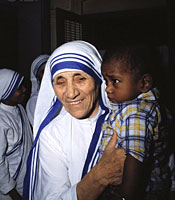
- I have found the paradox, that if you love until it hurts, there can be no more hurt, only more love.
- I think I'm more difficult than critical.
- I want you to be concerned about your next door neighbor. Do you know your next door neighbor?
- I try to give to the poor people for love what the rich could get for money. No, I wouldn't touch a leper for a thousand pounds; yet I willingly cure him for the love of God. " If we have no peace, it is because we have forgotten that we belong to each other.
- If we want a love message to be heard, it has got to be sent out. To keep a lamp burning, we have to keep putting oil in it.
- If you can't feed a hundred people, then feed just one.
- If you judge people, you have no time to love them.
- If you want a love message to be heard, it has got to be sent out. To keep a lamp burning, we have to keep putting oil in it.
- In this life we cannot do great things. We can only do small things with great love.
- Intense love does not measure, it just gives.
- It is a kingly act to assist the fallen.
- It is a poverty to decide that a child must die so that you may live as you wish.
- It is easy to love the people far away. It is not always easy to love those close to us. It is easier to give a cup of rice to relieve hunger than to relieve the loneliness and pain of someone unloved in our own home. Bring love into your home for this is where our love for each other must start.
- It is not the magnitude of our actions but the amount of love that is put into them that matters.
- It is impossible to walk rapidly and be unhappy
- Jesus said love one another. He didn't say love the whole world.
- Joy is a net of love by which you can catch souls.
- Kind words can be short and easy to speak, but their echoes are truly endless.
- Let us always meet each other with smile, for the smile is the beginning of love.
- Let us not be satisfied with just giving money. Money is not enough, money can be got, but they need your hearts to love them. So, spread your love everywhere you go.
- Let us more and more insist on raising funds of love, of kindness, of understanding, of peace. Money will come if we seek first the Kingdom of God - the rest will be given.
- Let us touch the dying, the poor, the lonely and the unwanted according to the graces we have received and let us not be ashamed or slow to do the humble work.
- Loneliness and the feeling of being unwanted is the most terrible poverty.
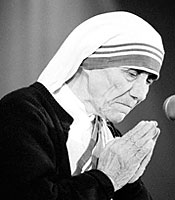
- Loneliness is the most terrible poverty.
- Love begins at home, and it is not how much we do... but how much love we put in that action.
- Love is a fruit in season at all times, and within reach of every hand.
- Love begins by taking care of the closest ones - the ones at home.
- Many people mistake our work for our vocation. Our vocation is the love of Jesus.
- One of the greatest diseases is to be nobody to anybody.
- Our life of poverty is as necessary as the work itself. Only in heaven will we see how much we owe to the poor for helping us to love God better because of them.
- Peace begins with a smile.
- So many signatures for such a small heart.
- Spread love everywhere you go. Let no one ever come to you without leaving happier.
- Sweetest Lord, make me appreciative of the dignity of my high vocation, and its many responsibilities. Never permit me to disgrace it by giving way to coldness, unkindness, or impatience.
- The biggest disease today is not leprosy or tuberculosis, but rather the feeling of being unwanted.
- The greatest destroyer of peace is abortion because if a mother can kill her own child, what is left for me to kill you and you to kill me? There is nothing between.
- The hunger for love is much more difficult to remove than the hunger for bread.
- The most terrible poverty is loneliness and the feeling of being unloved.
- The miracle is not that we do this work, but that we are happy to do it.
- The success of love is in the loving - it is not in the result of loving. Of course it is natural in love to want the best for the other person, but whether it turns out that way or not does not determine the value of what we have done.
- There are no great things, only small things with great love. Happy are those.
- There is always the danger that we may just do the work for the sake of the work. This is where the respect and the love and the devotion come in - that we do it to God, to Christ, and that's why we try to do it as beautifully as possible.
- There is more hunger in the world for love and appreciation in this world than for bread.
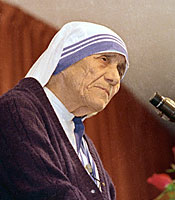
- There must be a reason why some people can afford to live well. They must have worked for it. I only feel angry when I see waste. When I see people throwing away things that we could use.
- There should be less talk; a preaching point is not a meeting point. What do you do then? Take a broom and clean someone's house. That says enough.
- We are all pencils in the hand of God.
- We can do no great things, only small things with great love.
- We need to find God, and he cannot be found in noise and restlessness. God is the friend of silence. See how nature - trees, flowers, grass- grows in silence; see the stars, the moon and the sun, how they move in silence... We need silence to be able to touch souls.
- We ourselves feel that what we are doing is just a drop in the ocean. But the ocean would be less because of that missing drop.
- We shall never know all the good that a simple smile can do.
- We think sometimes that poverty is only being hungry, naked and homeless. The poverty of being unwanted, unloved and uncared for is the greatest poverty. We must start in our own homes to remedy this kind of poverty.
- Words which do not give the light of Christ increase the darkness.
- We, the unwilling,led by the unknowing,are doing the impossible for the ungrateful. We have done so much,for so long,with so little,we are now qualified to do anything with nothing.
Indira Gandhi Quotes
- Even if I died in the service of the nation, I would be proud of it. Every drop of my blood... will contribute to the growth of this nation and to make it strong and dynamic.
- Anger is never without an argument, but seldom with a good one.
- Have a bias toward action - let's see something happen now. You can break that big plan into small steps and take the first step right away.
- If I die a violent death, as some fear and a few are plotting, I know that the violence will be in the thought and the action of the assassins, not in my dying.
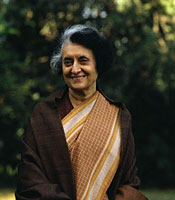
- Forgiveness is a virtue of the brave.
- Martyrdom does not end something, it only a beginning.
- People tend to forget their duties but remember their rights.
- My grandfather once told me that there were two kinds of people: those who do the work and those who take the credit. He told me to try to be in the first group; there was much less competition.
- The power to question is the basis of all human progress.
- You cannot shake hands with a clenched fist.
- You must learn to be still in the midst of activity and to be vibrantly alive in repose.
Mother Teresa Biography
Died: September 5, 1997
Achievements: Started Missionaries of Charity in 1950; received Nobel Prize for Peace in 1979; received Bharat Ratna in 1980.
Mother Teresa was one of the great servants of humanity. She was an Albanian Catholic nun who came to India and founded the Missionaries of Charity in Kolkata. Her selfless work among the poverty-stricken people of Kolkata (Calcutta) is an inspiration for people all over the world and she was honored with Nobel Prize for her work.
Mother Teresa's original name was Agnes Gonxha Bojaxhiu. She was born on August 27, 1910 in Skopje, Macedonia. Her father was a successful merchant and she was youngest of the three
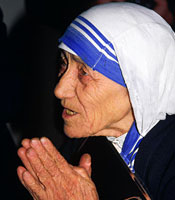 siblings. At the age of 12, she decided that she wanted to be a missionary and spread the love of Christ. At the age of 18 she left her parental home in Skopje and joined the Sisters of Loreto, an Irish community of nuns with missions in India.
siblings. At the age of 12, she decided that she wanted to be a missionary and spread the love of Christ. At the age of 18 she left her parental home in Skopje and joined the Sisters of Loreto, an Irish community of nuns with missions in India.After a few months of training at the Institute of the Blessed Virgin Mary in Dublin Mother Teresa came to India. On May 24, 1931, she took her initial vows as a nun. From 1931 to 1948, Mother Teresa taught geography and catechism at St. Mary's High School in Calcutta. However, the prevailing poverty in Calcutta had a deep impact on Mother Teresa's mind and in 1948, she received permission from her superiors to leave the convent school and devote herself to working among the poorest of the poor in the slums of Calcutta.
After a short course with the Medical Mission Sisters in Patna, she returned to Calcutta and found temporary lodging with the Little Sisters of the Poor. She started an open-air school for homeless children. Soon she was joined by voluntary helpers, and she received financial support from church organizations and the municipal authorities. On October 7, 1950, Mother Teresa received permission from the Vatican to start her own order. Vatican originally labeled the order as the Diocesan Congregation of the Calcutta Diocese, and it later came to known as the "Missionaries of Charity". The primary task of the Missionaries of Charity was to take care of those persons who nobody was prepared to look after.
The Missionaries of Charity, which began as a small Order with 12 members in Calcutta, today has more than 4,000 nuns running orphanages, AIDS hospices, charity centres worldwide, and caring for refugees, the blind, disabled, aged, alcoholics, the poor and homeless and victims of floods, epidemics and famine in Asia, Africa, Latin America, North America, Poland, and Australia. In 1965, by granting a Decree of Praise, Pope Paul VI granted Mother Teresa permission to expand her order to other countries. The order's first house outside India was in Venezuela. Presently, the "Missionaries of Charity"
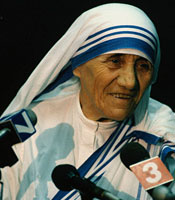 has presence in more than 100 countries.
has presence in more than 100 countries.Mother Teresa's work has been recognised and acclaimed throughout the world and she has received a number of awards and distinctions. These include the Pope John XXIII Peace Prize (1971), Nehru Prize for Promotion of International Peace & Understanding (1972), Balzan Prize (1978), Nobel Peace Prize (1979) and Bharat Ratna (1980).
On March 13, 1997, Mother Teresa stepped down from the head of Missionaries of Charity and died on September 5, 1997, just 9 days after her 87th birthday. Following Mother Teresa's death, the Holy See began the process of beatification, the second step towards possible canonization, or sainthood. This process requires the documentation of a miracle performed from the intercession of Mother Teresa. In 2002, the Vatican recognized as a miracle the healing of a tumor in the abdomen of an Indian woman, Monica Besra, following the application of a locket containing Teresa's picture. Monica Besra said that a beam of light emanated from the picture, curing the cancerous tumor. Mother Teresa was formally beatified by Pope John Paul II on October 19, 2003 with the title Blessed Teresa of Calcutta. A second miracle is required for her to proceed to canonization.
Indira Gandhi Biography
Died: October 31, 1984
Achievements: Became President of Indian National Congress in 1959; was Minister of Information and Broadcasting in Lal Bahadur Shastri's government; became Prime Minister in 1966; nationalized major banks in 1969; gave the slogan of Garibi Hatao during 1971 general elections; led India to a decisive war against Pakistan in 1971.
Indira Gandhi, one of the best-known women of the 20th century, was Prime Minister of India, and daughter of former Prime Minister Jawaharlal Nehru. Also known as Indira Nehru Gandhi, she was born on November 19, 1917 in Allahabad. She was born in a family that was at the centre of Indian freedom movement. Her father Jawaharlal Nehru and grandfather Motilal Nehru were at the forefront of Indian freedom struggle. Her mother Kamla Nehru, although less involved politically, was subject to political arrest by the British. Indira Gandhi had a lonely childhood, with some of her most vivid remembrances being the entry into her home of British policemen. As her parents did not want to send her to any of the British schools in India, Indira Gandhi's education took place at a series of Indian schools and at non-British schools in Europe, with a number of private tutorials interspersed between periods at school.
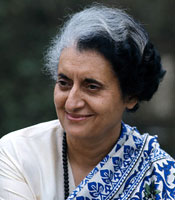 Indira Gandhi married a Parsi named Feroze Gandhi in 1942. The marriage was opposed by orthodox Hindus because it was an intercommunal love marriage not arranged by her parents. Jawaharlal Nehru too opposed the marriage on grounds that the couple were somewhat incompatible because both possessed fiery tempers. Publicly, however, both Jawaharlal Nehru and Mahatma Gandhi strenuously defended the marriage. Shortly after their marriage both Indira Gandhi and Feroze Gandhi were arrested and jailed for nationalist activities. Indira Gandhi was released after eight months and Feroze Gandhi after an year. After the release Feroze Gandhi became editor of The National Herald, a newspaper founded by Jawaharlal Nehru, and Mrs. Indira Gandhi became the principal confidant and assistant of her father during the period of Nehru's prime ministership (1947-1965). The couple separated for a number of years during the 1950s as Feroze Gandhi launched his own political career in Parliament and was often at odds with Jawaharlal Nehru's policies and style. In 1959 Indira Gandhi became President of the Indian National Congress and in 1964 she was elected to the parliament. Meanwhile, the death of Feroze Gandhi (from a heart attack) in 1960, and the subsequent death of her father in 1964, caused Indira Gandhi to withdraw into a shell and limit herself to her immediate family.
Indira Gandhi married a Parsi named Feroze Gandhi in 1942. The marriage was opposed by orthodox Hindus because it was an intercommunal love marriage not arranged by her parents. Jawaharlal Nehru too opposed the marriage on grounds that the couple were somewhat incompatible because both possessed fiery tempers. Publicly, however, both Jawaharlal Nehru and Mahatma Gandhi strenuously defended the marriage. Shortly after their marriage both Indira Gandhi and Feroze Gandhi were arrested and jailed for nationalist activities. Indira Gandhi was released after eight months and Feroze Gandhi after an year. After the release Feroze Gandhi became editor of The National Herald, a newspaper founded by Jawaharlal Nehru, and Mrs. Indira Gandhi became the principal confidant and assistant of her father during the period of Nehru's prime ministership (1947-1965). The couple separated for a number of years during the 1950s as Feroze Gandhi launched his own political career in Parliament and was often at odds with Jawaharlal Nehru's policies and style. In 1959 Indira Gandhi became President of the Indian National Congress and in 1964 she was elected to the parliament. Meanwhile, the death of Feroze Gandhi (from a heart attack) in 1960, and the subsequent death of her father in 1964, caused Indira Gandhi to withdraw into a shell and limit herself to her immediate family.After the death of Jawaharlal Nehru, Lal Bahadur Shastri became Prime Minister and Indira Gandhi was the minister of Information and Broadcasting in his government. After Lal Bahadur Shastri's untimely death in 1966, she was selected as prime minister by party bosses within the Congress Party as a compromise candidate. Her candidature was opposed by Morarji Desai, a veteran nationalist and prime ministerial aspirant himself. The Congress bosses were apparently looking for a leading figure acceptable to the masses, who could not only command general support during the next general election but who would also acquiesce to their guidance. In her initial days as Prime Minister, Indira Gandhi encountered numerous problems such as Mizo tribal uprisings in the northeast; famine, labour unrest,and misery among the poor in the wake of rupee devaluation; and agitation in Punjab for linguistic and religious separatism.
In the fourth general elections held in 1967, Congress suffered a major setback. Congress majority was greatly reduced in parliament and non-Congress ministries were established in Bihar, Kerala, Orissa, Madras, Punjab, and West Bengal. This forced Mrs. Indira Gandhi to become assertive and opt for a series of choices that pitted her directly against the Congress Party high command, which had previously been built up by her father. Seeking to eradicate poverty, Mrs. Gandhi pursued a vigorous policy in 1969 of land reform and placed a ceiling on personal income, private property, and corporate profits. She also nationalized the major banks, a bold step amidst a growing rift between herself and the party elders. The Congress expelled her for "indiscipline" on November 12, 1969, an action that split the party into two factions: the Congress (O)-for Organisation-led by Morarji Desai, and the Congress (I)--for Indira-led by Indira Gandhi.
Indira Gandhi campaigned fiercely on the slogan of "Garibi Hatao" (eliminate poverty) during the fifth general elections in March 1971 and won an unprecedented two-third majority. Her leadership qualities came to the fore during India-Pakistan war in 1971 that resulted in liberation of Bangladesh. India achieved decisive victory over Pakistan in the face of diplomatic opposition from both China and the United States and a lack of international support from almost every other nation except the Soviet Union and the Eastern Bloc countries. Indian victory over Pakistan led to a great surge in Indira Gandhi's popularity and she was compared to Goddess Durga by ordinary Indians.
Expectations raised by the garibi hatao campaign
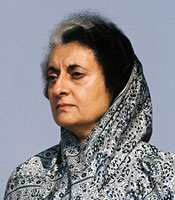 and India's victory over Pakistan in 1971 led to great disappointment and political difficulties in the mid-1970s. Enormous economic cost of 1971 war, increase in world oil prices and, drop in industrial output added to the economic hardships. During this time J.P.Narayan initiated a civil disobedience movement against Indira Gandhi. In June 1975, amidst all this crises Allahabad High Court invalidated her 1971 election on the grounds of electoral malpractices. Instead of resigning, Indira Gandhi declared an Emergency in the country and jailed al her political opponents. The Emergency lasted till March 1977 and in the general election held afterwards she was defeated by a coalition of parties called Janta Morcha.
and India's victory over Pakistan in 1971 led to great disappointment and political difficulties in the mid-1970s. Enormous economic cost of 1971 war, increase in world oil prices and, drop in industrial output added to the economic hardships. During this time J.P.Narayan initiated a civil disobedience movement against Indira Gandhi. In June 1975, amidst all this crises Allahabad High Court invalidated her 1971 election on the grounds of electoral malpractices. Instead of resigning, Indira Gandhi declared an Emergency in the country and jailed al her political opponents. The Emergency lasted till March 1977 and in the general election held afterwards she was defeated by a coalition of parties called Janta Morcha.Factionalism among coalition partners led to the collapse of Janta government and Indira Gandhi came back to the power once again in 1980. But her second innings was beset with difficulties and personal tragedies. Her younger son Sanjay Gandhi died in an air crash. Her government was confronted with serious challenges to its ability to maintain law and order as conflicts between religious and ethnic groups broke out in different parts of the country. After the army had invaded the Golden Temple in Amritsar, the chief shrine of the Sikhs, which had been held as an armed camp by a group of militant Sikhs, she became the target for Sikh anger and on 31 October 1984 she was assassinated by her own Sikh bodyguard.
Mahatma Gandhi Pictures
